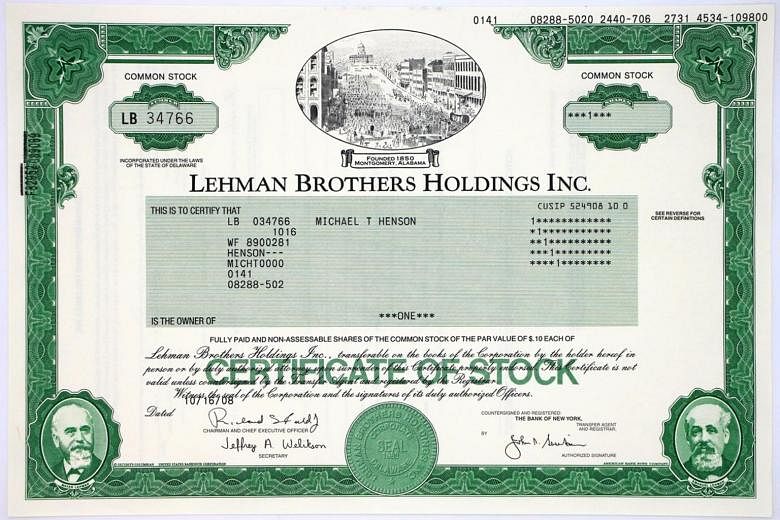(NYTIMES) - Lehman Brothers' stocks may be worthless now but you are definitely in the money if you happen to have cartons of the company's old T-shirts.
Whenever Mr Jack Carlson wears his mum's old green Lehman's sweatshirt around New York City, people literally want to buy it off his back.
"People will just come up to me and offer me money for it in restaurants," said Mr Carlson, 33, the founder of clothing company Rowing Blazers, which sells a contemporary version of the so-called banker bag, a Wall Street accessory that dates back to 1978.
Also in demand are branded merchandise of defunct investment banks that were key architects of the financial crisis in 2008.
Buying and selling products associated with the crash has become, paradoxically, a thriving niche market. So, too, has memorabilia associated with other disasters in recent financial history, like the dot.com bubble and the Enron scandal.
Mr Akshay Shah, founder of investment firm Kyma Capital, said: "When businesses go bust, they leave behind reminders of corporate power and the effects of time."
He noted that eBay sellers have scooped up branded items and offered them for sale "at a pretty substantial multiple after a suitable passage of time" - like the US$500 (S$665) Lehman sticky notes.
These days, however, there are also more affordable items on hand, a Lehman Brothers-branded baby bib (US$59.59 on eBay) and an emergency evacuation kit (US$98.99)
A Shearson-Lehman Bros certificate dated to 1987 will set you back US$295, however - even though the stock it once represented is worth nothing.
And an Enron conduct of business affairs booklet is on sale for US$395 on the stock market gifts and collectibles website Wall Street Treasures.
"I've been selling a lot of Enron memorabilia lately," said Mr Scott Davidson, an accountant and financial planner who runs Wall Street Treasures. The 38-year-old has been selling finance-related memorabilia through various channels for nine years.
"There's a lot of appetite. Everyone loves a good scandal." Among the current items Mr Davidson has in stock is a framed promotional piece that displays a Most Innovative Company Award that went to Enron four years in a row. It is now on sale for US$1,495.
In a disorienting boomerang of value, a once-valuable stock certificate becomes worthless, and then, in an afterlife as a collectors' item, becomes more valuable than it was before. Why, one might ask, is anyone buying this stuff? Financial scandals and crises, which left millions of people impoverished, might seem like odd fodder for office decor or workout sweatshirts.
"I think it partly has to do with collective identity," Mr Davidson said. "So many people owned a piece of Enron at one time, through their mutual funds. Everyone knew the story." Personal identity is part of it, too; he often gets contacted by former employees of defunct companies looking for souvenirs of their time there.
This buying and selling of finance-adjacent memorabilia is a cousin of scripophily, the collecting of stock certificates: a niche hobby among, mostly, financial professionals and history buffs.
Paper stock and bond certificates, which are being phased out of circulation, are often highly decorative objects.
Mr Bob Kerstein, 68, founded scripophily.com, the primary website for buying and selling stock and bond certificates, in 1996.
He now has roughly 14,000 of them on the website, ranging from stock certificates for 19th century mining companies to Ask Jeeves stock issued in 2001, with Jeeves himself on the top.
"The financial crisis is one of our biggest sellers right now," Mr Kerstein said. "We have mortgage obligation bonds on our website, and people like those a lot, because that was really the starting point of the Great Recession."
When he first started, he said, collectors were most interested in the older certificates but now, "modern certificates are more popular".
The idea that objects can impute lessons about the follies of money management is not a new one.
Professor William Goetzmann at the Yale School of Management is co-author of the book The Great Mirror Of Folly: Finance, Culture, And The Crash Of 1720, inspired partly by memorabilia of the first great stock market crash.
This crash, popularly known as the South Sea Bubble, inspired a range of scrapbooks and satirical drawings that pointed to the absurdities of speculating.
There are even playing cards printed with satirical drawings of the crash; people may well have gambled with cards that poked fun at the feverish atmosphere of trading and speculating that led to the crash.
"Saving the artefacts from stock market crises is about more than just saying, 'We want something to remember it'," Prof Goetzmann said. "It's about having something that you can use ironically or satirically to force yourself to realise that human behaviour can lead to these crises."
This seems to be part of what is at work in the obsession with Lehman Bros and Enron memorabilia - not just memorialising scandals or crises, but also processing them through irony.
Sometimes, that means buying and selling in a mode of speculation that mimics the very thing you are mocking.

